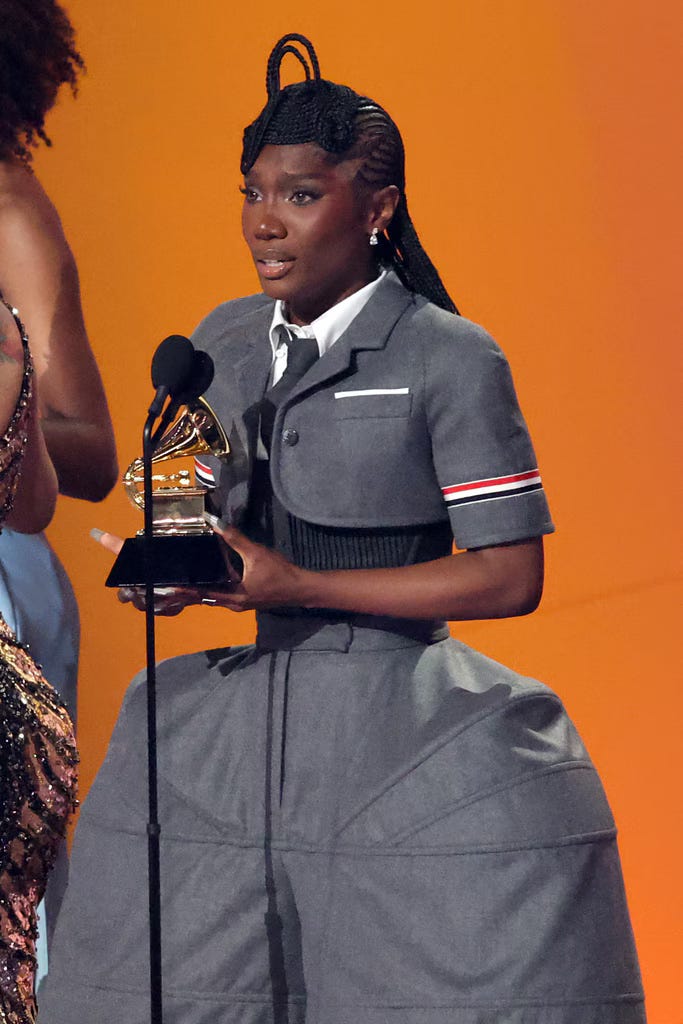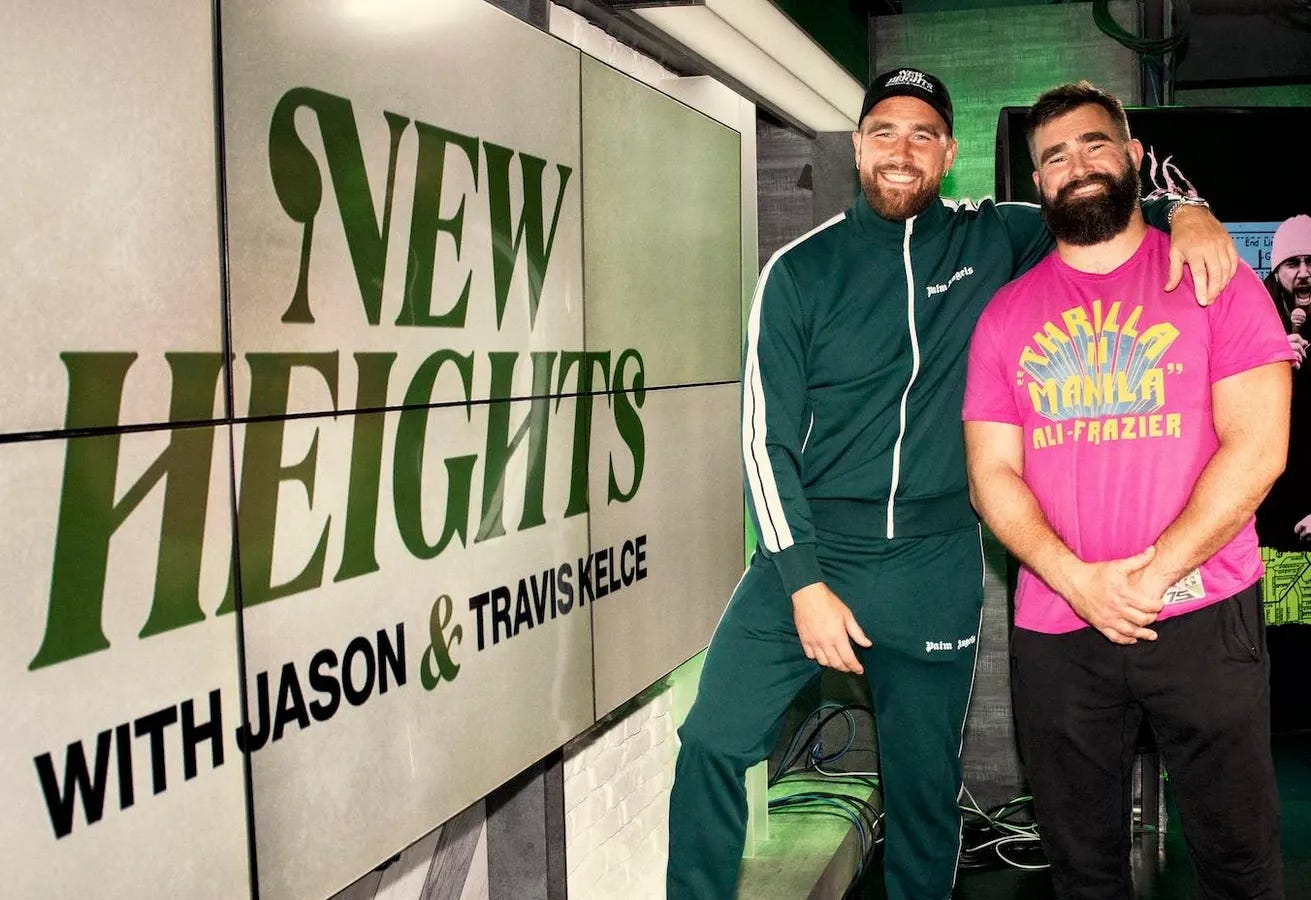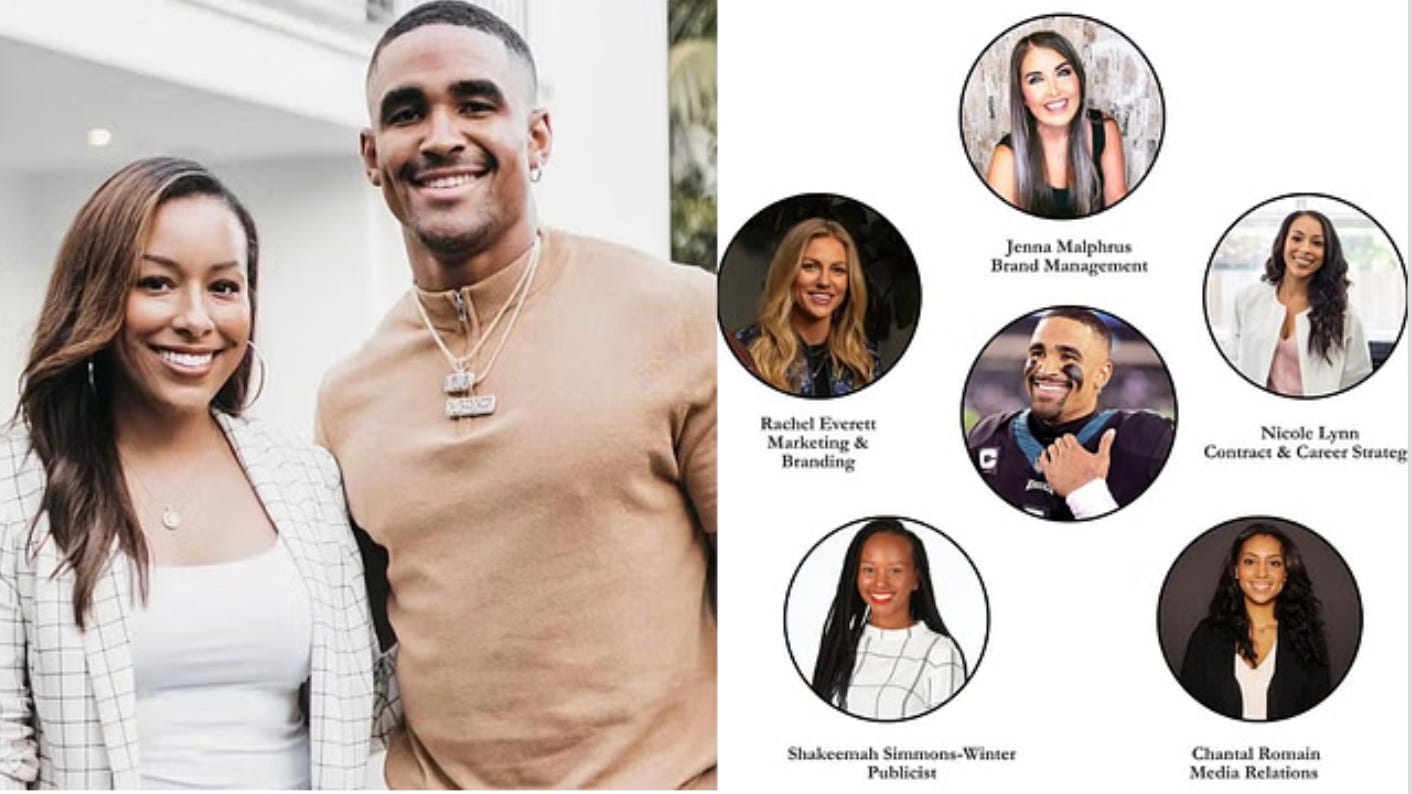Maybe being an "industry plant" isn't all that bad 🌱
Is being an "industry plant" really that much of a bad thing? Or is it only "bad" when the pop girls do it?
(Pictured above: Doechii, Sabrina Carpenter, Chappell Roan and Gracie Abrams)
Every year at the Grammys, one of the most talked about categories is “Best New Artist”. This year, the category was potentially one of the most competitive in a long time. From Chappell Roan to Doechii to Sabrina Carpenter to Teddy Swims (and more).
But it wouldn’t be a true “best new artist” campaign without claims of “industry plant” being thrown at the artists nominated on social platforms like X, Reddit and TikTok.
Typically, people think of industry plants with a negative connotation and that it is a dark conspiracy. But I challenge that belief. Not only do I think the word “industry plant” is simply an internet buzzword to describe a perfectly healthy part of the entertainment ecosystem, but I also think it is a term that it is often thrown at women or minorities in an attempt to discredit their success.
The term “industry plant” essentially became a coded way to say, “There is no way a woman or a minority could be successful based on their own merit. No, it must have been the powers that be who hand-selected them in a mysterious boardroom to push on the masses, regardless of their talent, grit or vision. They were going to be famous, no matter what. Not because they earned it but because the powerful people decided it for them.”
In this article, we are going to take away the derogatory nature of the word “industry plant” and instead peel back the layers to how fame is curated and nurtured so you, too, can seek out the audience for your hard work, whatever that is.
Maybe with these marketing tools, you can be the next “industry plant”. 🌱
No one ever says a man like Travis Kelce is an industry plant. Seeking out fame and visibility for your hard work is only seen as a sinister ploy when it’s done by other groups of people. I would argue that Kelce has wanted fame for over a decade now. And there is nothing wrong with that.
In 2016, he had a dating show on E! called, “Catching Kelce”. In the Bachelor-style dating show, Kelce dated 50 women from 50 states. You can watch the preview clip below:
Since then, the pro-footballer has launched a popular podcast alongside his older brother, Jason Kelce, called “New Heights”. The Wondery podcast regularly ranks in the Top 10 podcasts in the world and has catapulted the footballer’s persona even more.
But most notably, Kelce solidified his spot as a household name when he began dating superstar, Taylor Swift. Swift told Time magazine that their romance began after he talked about his interest in her during his podcast. This man knows how to garner attention…and there is nothing wrong with it!
In order to become a “household name”, one must be known by every generation in a household. If your name is only known by one generation in the house; such as, the Gen-Z chronically online teenagers or the Gen-X dad’s who still watch sitcom reruns, then you are still a somewhat niche celebrity.
Travis Kelce was a somewhat niche celebrity until he dated Taylor Swift. The dads, grandpas and brothers knew of him from football. But now the teenage daughters and millennial mom’s knew him because of his relationship.
By all definitions, Travis Kelce is what one could consider an “industry plant”. He had institutions backing him to try and manufacture more fame than what football could provide. The suits at E! Network gave him a dating show almost 10 years ago. Now, he is signed to Wondery podcasts which is owned by the biggest company in the world, Amazon. He is now dating Taylor Swift, which happened because he brought her up on his Amazon-owned podcast. The NFL has made him and his brother the face of friendly rivalry in the football world.
He has huge institutions backing him. It seems he wants to be famous. And that is okay.
(Article above linked here)
People online seem to think that someone is an “industry plant” if they appeared out of no where. But that is often precisely how fame works, especially on the internet.
I wrote a Substack article previously about Sabrina Carpenter (that you can read here) and in it, I pointed out her speech at the “Variety Hitmakers Award Show” where she described herself as a “turtle”. She talked about how slow her career has been to take off. How she watched her contemporaries find success almost over night (Olivia Rodrigo, maybe?) and how she had put out 6 albums and was still struggling to find that “overnight success”. But the following year, she would put out her Grammy-winning album, “Short ‘n Sweet”, and would solidify her spot as a household name forever.
Much like Kelce, Carpenter had been trying to find fame and recognition for her work for close to a decade. And as I am sure both of them know, fame is random and you can’t always control how or when it will hit. But you can do a few things to ensure you are ready to catch lightning in a bottle when and if it does.
In order to find fame, and become an “industry plant”, one must focus on these three pillars:
1. Repetition
I have talked about this in articles before but “branding” is just a fancy, corporate word for “repetition”. The biggest brands, celebrities and influencers often become a household name once they find something they can repeat over and over until they become known for it.
Audiences are already shown hundreds of pieces of content a day. When they see a face or brand, they are more likely to stick around if it is familiar. This also coincides with a marketing phenomenon known as “the decision paradox”. People are less likely to buy a product or stick around if they feel like there is too much variety and they constantly have to narrow down their options. Humans like repetition.
The podcast “Nudge” had a great episode on the decision paradox that you can listen to here
Some people achieve this visually. They wear the same outfit over and over again or do their hair a certain way. For Grammy-winning artist Doechii, she began blowing up when she began wearing face tape as her staple. She wore it in her NPR Tiny Desk Performance, on red carpets and even at the Grammy’s.
My favorite song of Doechii’s is called “PROFIT” for anyone curious.
Of course the main factor to her recent success is her hard work, talent and vision. But as someone who reports on marketing, I love to talk about the correlation between when someone begins implementing a marketing strategy and when they begin blowing up even more, since that is what I specialize in.
Another example of the power of repetition would be Chappell Roan. She began to paint her face white as part of a drag persona and to lean into the fact that she was once bullied and called a “clown” growing up. She even had clowns on stage with her for her Grammy performance.
When industry leaders and social media platforms are looking for the next big thing to push out on their algorithms, they are often looking for repetition. Plus, audiences are less likely to follow your account, music or brand if they click on it and every day you are doing something completely different. Oftentimes, media companies that have multiple faces on their accounts every day will lean on formats and niches to grow a cult-like audience.
Red Bull is one of the most followed brands across all socials and they consistently post clips of extreme sports daily. They don’t switch it up by posting clips of someone knitting one day, reading a book the next day, then a makeup tutorial on the third day. No, they stick to their niche: extreme sports. And as a result, have gained 16 million followers on their main TikTok account, as a result.
What other “industry plants” have found fame after leaning into one format, look or sound? Comment below if you are a paying member of the Susbtack ⬇️
2. The Team:
This factor is much harder to control but still so important. The best artists, creators and brands are often at the top of their game, not because they are much more creative or talented than everyone else, but usually because they are the best at identifying talent and building a strong team around them.
Dan Nigro is not a household name artist but he is the producer who has helped Olivia Rodrigo and Chappell Roan create their biggest hits. Make it a mission to find your “Dan Nigro”.
This often takes time to do. Sabrina Carpenter and Chappell Roan famously got dropped by or left their first record labels before both landing at Island Records. You might be at your first “label” right now, and that is okay.
Finding the right team is a lot like needing new eye glasses but going to the dentist. It doesn’t mean either of you are “bad” at what you do. It just means you are looking in the wrong place. The earlier you can recognize who the “dentists” are in your life and switch it out for an ophthalmologists, the quicker you can get that pair of glasses on and see your vision much clearer.
(Credit: sportsish on Instagram)
Jalen Hurts is the NFL Quarterback for the Philadelphia Eagles and he has been going viral online for talking openly about how he built an all-female team around him. He said it was because he felt that they could bring a fresh perspective and give him an advantage. It must be working because I learned of his name for the first time this week when I began seeing clips on my FYP about Jalen Hurts and his all-female team.
Having a good team arounds you allows you to do the one thing all “industry plants” are accussed of. Making it look too easy. But that is the paradox of fame. It is an immeasurable resource that takes so much effort to create and maintain yet the audience is only interested if it looks effortless.
If you aren’t sure where to find the right team, start by following your favorite artists and creators stylists, producers and anyone they give credit to on their stories or captions. While you might not work directly with any of the people they mention, seeing the inner workings of how to make a star allows you to train your eye to know what to look for when building out your own team.
Three of my favorite accounts to follow on Instagram are:
Jared Ellner: He is the stylist for Emma Chamberlain, Sabrina Carpenter and more
Genesis Webb: She is the stylist for Chappell Roan
Hannah Lux Davis: She is the music video director for big stars like Ariana Grande, Tate McRae and Doja Cat
And lastly, let’s talk about the last pillar to becoming an industry plant:
3. Time
I know this is so frustrating because time is the one variable that is completely out of our control. But it is still one of the most important ingredients for success.
The next generation of artists and creators to become household names between 2025-2035 are most likely posting videos and art today, as we speak, that are getting less than 100 views. A true artist knows that they must clock in their hours. You must build out an archive of great videos, art or products so that when lightning strikes, people are more likely to follow because they see a whole catalogue of content they can dive into.
When lightning strikes, you must give them a bottle to catch it in.
Nothing is worse than finding a new show you love and then you realize it was cancelled after the pilot episode or season one. Instead, shows like “Game of Thrones” and “Succession” became sleeper hits because by the time it picked up momentum online, there were a couple seasons that new viewers could go back and binge-watch.
Doechii famously posted lifestyle videos to her YouTube channel as recently as 2020. One video titled, “I got fired today thank GOD” still lives on the same YouTube channel where she posts music videos with 18 million+ views. And I love that she kept it up!
And the pillar of time brings me to one of my favorite analogies that I read in a book once (I wish I remembered the name but I read an embarrasingly large amount of self-help books lol). The analogy was about the way bamboo grows.
Once planted, a Chinese bamboo tree must be watered for five years before it begins to sprouts. Imagine how slow it must feel to water a plant every day for five years, even when you see no evidence of it breaking the surface. You have no evidence of if your efforts are working or not. You are only going on blind trust. But what you can’t see is that the bamboo is growing it’s roots under the soil and naked to the human eye.
(source: mycollaborativeteam)
The reason the plant must spend five years growing it’s roots before it begins to show any evidence of existing on top of the soil is because it can sprout up to 90 feet tall within the first five weeks of it breaking the soil. If it wasn’t for the bamboo growing it’s roots in the soil where no one can see, it would topple over almost instantaneously as it would not have the support system to hold up it’s 90 foot limbs.
As a creative, you must be like the person who continues to water the bamboo for five years with no evidence of the tree existing. Your art, your vision and your work ethic is building a root system where no one else can see for five years so that when lighting strikes, you have the foundation to not topple over when you are handed newfound fame.
So that brings me to my final point. Maybe these women were all “industry plants”. Like the bamboo tree; they took years honing their craft, building a secure team around them, and finding what works when no one was looking. When no one else could see what was happening under the soil, including themselves. They planted themselves, just like a bamboo tree, and watered it for years with no knowledge of just how massive they would eventually sprout.
If you have read this far, thank you so much for being a coconut! This was a free article but if you want a deeper dive into marketing and pop culture every Monday and Friday - then be sure to become a paying member so you can unlock the weekly trend reports and extended episodes of the “Ahead of the Curve” podcast.




















Only paying coconuts can comment! Join the fun if you want to leave any thoughts below 🥥 ❤️
such a great watch and read, coco! I went to a bamboo garden over the weekend and thought about what you said about watering bamboo for five years before it grows. love applying your branding insights to my music! here's to hopefully being the next industry plant 🌱❤️